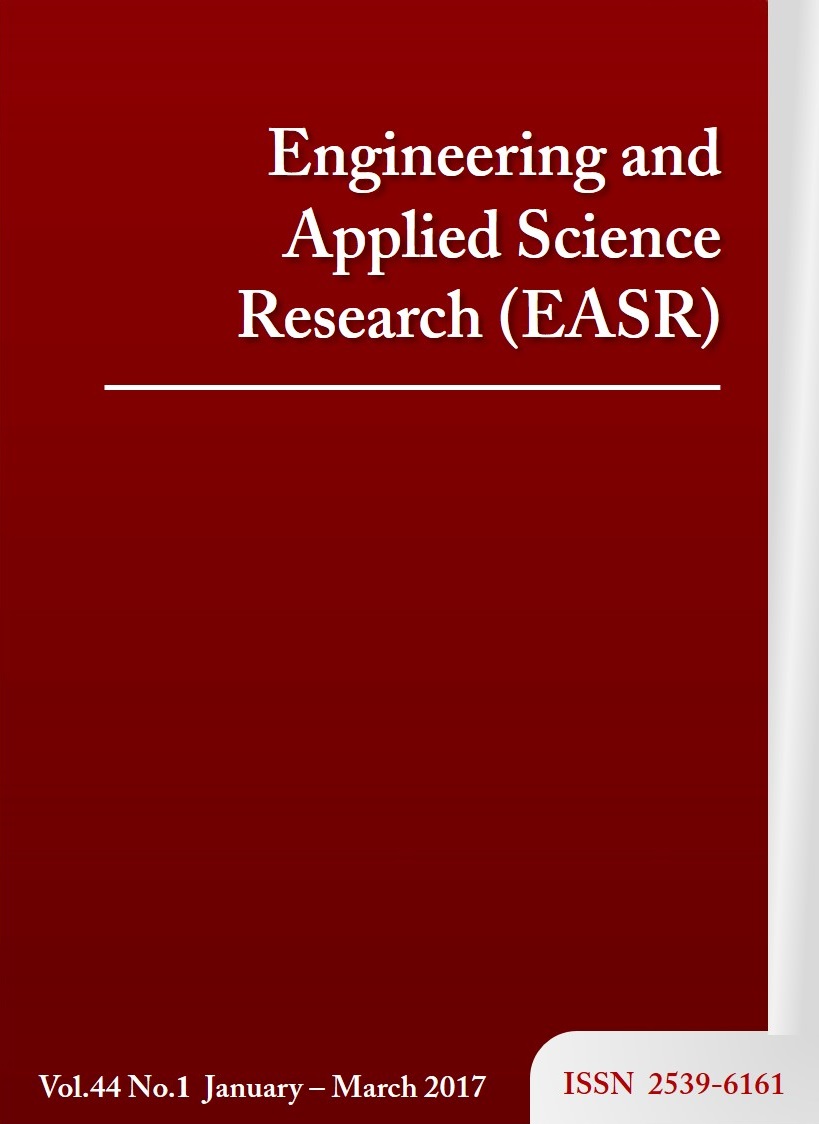GHG emission quantification for pavement construction projects using a process-based approach
Main Article Content
Abstract
Climate change and greenhouse gas (GHG) emissions have attracted much attention for their impacts upon the global environment. Initiating of new legislation and regulations for control of GHG emissions from the industrial sectors has been applied to address this problem. The transportation industries, which include operation of road pavement and pavement construction equipment, are the highest GHG-emitting sectors. This study presents a novel quantification model of GHG emissions of pavement construction using process-based analysis. The model is composed of five modules that evaluate GHG emissions. These are: material production and acquisition, (2) material transport to a project site, (3) heavy equipment use, (4) on-site machinery use, and, (5) on-site electricity use. The model was applied to a hypothetical pavement project to compare the environmental impacts of flexible and rigid pavement types during construction. The resulting model can be used for evaluation of environmental impacts, as well as for designing and planning highway pavement construction.
Article Details
This work is licensed under a Creative Commons Attribution-NonCommercial-NoDerivatives 4.0 International License.
References
FHWA. Moving ahead for progress in the 21st century act (MAP-21) A summary of highway provisions. USA: Federal Highway Administration; 2012.
Santero NJ, Horvath A. Global warming potential of pavements. Environ Res Lett. 2009;4:1-7.
Athenasmi.org [Internet].Ontario: Athena Sustainable Material Institute; Athena impact estimator for highways [updated 2013 April; cited 2016 June 1]. Available from http://www.athenasmi.org/our-software-data/impact-estimator-for highways/.
Horvath A. Life-cycle environmental and economic assessment of using recycled materials for asphalt pavements. Technical Report. Berkeley: University of California Transportation Center; 2003 Sep.
Kim B, Lee H, Park H, Kim H. Framework for estimating greenhouse gas emissions due to asphalt pavement construction. J Construct Eng Manag. 2012;138(11):1312-21.
Dewan S, Smith R. Estimating international roughness index from pavement distresses to calculate vehicle operating costs for the San Francisco bay area. Transport Res Rec. 2002;1816(1):65-72.
Kim B, Lee H, Park H, Kim H. Greenhouse gas emissions from onsite equipment usage in road construction. J Construct Eng Manag. 2011; 138(8):982-90.
Bilec M, Ries R, Matthews HS, Sharrard AL. Example of a hybrid life-cycle assessment of construction processes. J Infrastruct Syst. 2006;12(4):207-15.
Crawford R. Life cycle assessment in the built environment. New York: Spon press; 2011.
Zapata P, Gambatese JA. Energy consumption of asphalt and reinforced concrete pavement materials and construction. J Infrastruct Syst. 2005;11(1):9-20.
Palaniappan S, Bashford H, Li K, Crittenden J, Fafitis A, Stecker L, Hay S. Carbon emissions of on-site equipment use in post-tensioned slab foundation nonstruction. In: Cai H, Kandil A, Hastak M, Dunston P, editors. Construction Research Congress 2012: Construction Challenges in a Flat World; 2012 May 21-23; West Lafayette, Indiana. Virginia: American Society of Civil Engineers. p. 1662-71.
Taborianski VM, Prado RT. Methodology of CO 2 emission evaluation in the life cycle of office building façades. Environ Impact Assess Rev. 2012;33(1):41-7.
Athena Institute. Impact estimator for highways: user guide. Canada: Athena Sustainable Materials Institute; 2013.
Athena Institute. A life cycle perspective on concrete and asphalt roadways: embodied primary energy and global warming potential. Canada: Athena Sustainable Materials Institute; 2006.
Matthews HS, Hendrickson C, Horvath A. External costs of air emissions from transportation. J Infrastruct Syst. 2001;7(1):13-7.
Park K, Hwang Y, Seo S, Seo H. Quantitative assessment of environmental impacts on life cycle of highways. J Construct Eng Manag. 2003;129(1): 25-31.
Treloar GJ, Love PE, Crawford RH. Hybrid life-cycle inventory for road construction and use. J Construct Eng Manag. 2004;130(1):43-9.
White P, Golden JS, Biligiri KP, Kaloush K. Modeling climate change impacts of pavement production and construction. Resour Conservat Recycl. 2010;54(11): 776-82.
International Energy Agency (IEA). Electricity information 2012. Paris: International Energy Agency; 2012.
International Energy Agency (IEA). CO2 emissions from fuel combustion-highlights. Paris: International Energy Agency; 2015.
Epa.gov [internet]. United States environemtal agency protection; Overview of greenhouse gases. [updated 2016 Feburay 24; cited 2016 June 1]. Available from: http://www3.epa.gov/climatechange/ghgemissions/ga ses.html.
KEITI [internet]. Korean environmental industry and technology institute; LCI DB information network. [updated 2015; cited 2016 May 1]. Available from http://www.epd.or.kr/en/lci/co2.asp.
Park J, Tae S, Kim T. Life cycle CO2 assessment of concrete by compressive strength on construction site in Korea. Renew Sustain Energ Rev. 2012;16(5): 2940-6.
Flower DJ, Sanjayan JG. Green house gas emissions due to concrete manufacture. Int J LCA. 2007;12(5): 282-8.
Hong TH, Ji CY, Jang MH, Park HS. Predicting the CO2 emission of concrete using statistical analysis. J Construct Eng Proj Manag. 2012;2(2): 53-60.
Peurifoy RL, Schexnayder CJ, Shapira A. Construction planning, equipment, and methods. New York: McGraw-Hill; 2006.
US EPA. Emission facts – Average carbon dioxide emissions resulting from gasoline and diesel fuel. USA: United states Environmental Protection Agency; 2005.
Eia.gov [internet]. U.S. Energy information administration; State electricity profiles. [updated 2016 March 24; cited 2016 June 1]. Available from http://www.eia.gov/ electricity/state/
Epa.gov [internet]. United States environmental agency protection; GHG equivalencies calculator - calculations and references. [updated 2016 May 31; cited 2016 June 1]. Available from: https:// www.epa.gov/energy/ghg-equivalencies-calculator-calculations-and-references.
Bilec MM, Ries RJ, Matthews HS. Life-cycle assessment modeling of construction processes for buildings. J Infrastruct Syst. 2009;16(3): 199-205.
Ochoa L, Hendrickson C, Matthews HS. Economic input-output life-cycle assessment of US residential buildings. J Infrastruct Syst. 2002;8(4):132-8.



